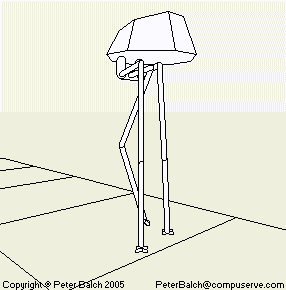
"A [lightning] flash, and it came out vividly, heeling over one way with two feet in the air, to vanish and reappear almost instantly as it seemed, with the next flash, a hundred yards nearer. Can you imagine a milking stool tilted and bowled violently along the ground? That was the impression those instant flashes gave. But instead of a milking stool imagine it a great body of machinery on a tripod stand."
A rotating gait could be made to work but it would very tricky. I've always assumed this description was a literary device rather than an attempt to specify the actual gait. I assume that the hood sensors and effectors always point forwards.
It seems to me that only three gaits are possible - let's call them the 123, the 2(13) and the (123) gaits.
The 123 gait has the three legs 120deg out of phase:

![]()
It's the gait that's closest to a horse walking. At any instant only one leg is off the ground.
You could lengthen each of the "on the ground" segments of the 123 gait so that sometimes three feet are on the ground. And you could shorten each of the "on the ground" segments so that sometimes only one foot is on the ground; that would be trotting. But you would never change the phase relation of the legs. That's like a bipedal gait. Humans have only one gait; the proportion of the time each foot is on the ground changes between walk, trot, run but the phase relation is always 180deg. Horses have several with different phase relations for walk, trot, canter and gallop.
When walking, the legs swing in straight line so the footsteps show three separate parallel lines. A tripod does not walk like a human whose footsteps are in a single line as it is difficult for the centre leg to zig-zag between the outer two. The body weaves from side to side so as to keep the centre of gravity over the point of maximum support. The speed of walking is tuned to match the period of both the pendulum of the legs and the inverted pendulum of the body above the feet.
The 2(13) gait is like a "one-legged-man on crutches":

![]()
This gait requires dynamic balancing while the centre leg is the only support. It's closest to bounding. When a greyhound or cheetah bounds, the front legs do not hit the ground at exactly the same time.
In the (123) gait, all the legs move together and act like a pogo stick:

![]()
This gait is the closest to a horse galloping.
